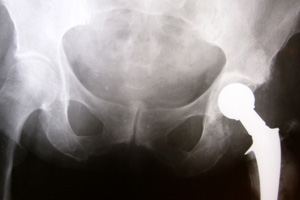DOCTORS and their patients with hip replacements can be reassured by a large new systematic review showing that traditional metal or ceramic-on-polythene implants are at least as effective as the controversial metal-on-metal implants.
Traditional implants using metal-on-polyethylene bearings were also found to have substantially lower rates of revision than metal-on-metal implants, according to the three largest registries reviewed.
The review, published in the BMJ, used data from more than 830 000 operations from national registries, including the Australian National Registry, as well as information from 18 studies involving more than 3100 patients comparing hip implants with various combinations of bearings. (1)
“Results do not indicate any advantage for metal on metal or ceramic on ceramic implants compared with traditional metal on polyethylene or ceramic on polyethylene bearings”, wrote the researchers, who included Australian orthopaedic surgeon Professor Stephen Graves of the University of Melbourne.
The study found that functional outcomes and general quality-of-life scores were no different among patients receiving modern or traditional implants, with some evidence favouring those receiving the traditional replacements.
Professor Graves, director of the Australian Orthopaedic Association National Joint Replacement Registry, told MJA InSight that the systematic review was reassuring in some ways.
“The majority of hip replacements use traditional bearings and they are working very well”, he said.
Surgeons would be less likely to recommend large-head metal-on-metal hip replacement as a result of this BMJ paper, Professor Graves said.
The systematic review is the latest instalment in the ongoing controversy regarding metal-on-metal hip replacements, which became popular because it was thought they would reduce the risk of dislocation and improve functional outcomes for younger patients.
“Our findings related to clinical outcomes of metal on metal implants are augmented by reports that show severe metallosis associated with such implants”, the BMJ authors wrote.
The BMJ also published a review of the assessment and management of patients with a metal-on-metal total hip replacement who present with potential joint failure. (2)
The review, conducted by orthopaedic surgeons and researchers from Australia and the UK, found revision surgery was usually indicated for these patients and outcomes were poorer than revision for other indications.
The MJA reported the first Australian cases of possible cobalt toxicity related to metal-on-metal hip replacements, with patients experiencing neurological and cardiovascular symptoms. (3)
DePuy Orthopaedics, in December 2009, voluntarily withdrew its two articular surface replacement metal-on-metal prostheses from the Australian market after they were found to have significantly higher revision rates than other prostheses. A worldwide recall of both implants in August 2010 involved an estimated 93 000 patients.
Metal-on-metal implants continue to be used in Australia, but their use has decreased in recent years, Professor Graves said. In 2010, they comprised less than 5% of conventional total hip replacements, with rates declining further in 2011.
A senate inquiry recently reviewed regulatory standards for medical devices, recommending increased rigour in assessment of such devices. (4)
Professor Graves said there was a re-emphasis on clinicians using an evidence-based approach to prostheses selection.
“Large head metal-on-metal conventional hip replacements were used based largely on theoretical rather than proven advantages. [The systematic review] paper highlights that they do not appear to have any advantage compared to traditional bearings”, he said.
The BMJ authors concluded there was an overall lack of strong evidence for the newer implants.
“A large and high quality randomised controlled trial of bearing surfaces in total hip replacement needs to be conducted before any claims of benefit are made”, they wrote.
– Sophie McNamara
1. BMJ 2011; 343: d7434
2. BMJ 2011; 343:d7441
3. MJA 2011; 194: 649-651
4. Parliament of Australia: The regulatory standards for the approval of medical devices in Australia
Posted 5 December 2011

 more_vert
more_vert